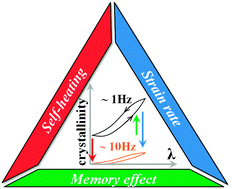Strain induced crystallization and melting of natural rubber during dynamic cycles
Abstract
Strain-induced crystallization (SIC) of natural rubber (NR) is studied during dynamic cycles at high frequencies (with equivalent strain rates ranging from 7.2 s−1 to 290 s−1). The testing parameters are varied: the frequency, the temperature and the stretching ratio domain. It is found that an increase of the frequency leads to an unexpected form of the CI–λ curve, with a decrease of the crystallinity during both loading and unloading steps of the cycle. Nevertheless, the interpretation of the curves needs to take into account several phenomena such as (i) instability of the crystallites generated during the loading step, which increases with the frequency, (ii) the memory of the previous alignment of the chains, which depends on the minimum stretching ratio of the cycle λmin and the frequency, and (iii) self-heating which makes the crystallite nucleation more difficult and their melting easier. Thus, when the stretching ratio domain is above the expected stretching ratio at complete melting λmelt, the combination of these phenomena, at high frequencies, leads to unexpected results such as complete melting at λmin, and hysteresis in the CI–λ curves.


 Please wait while we load your content...
Please wait while we load your content...